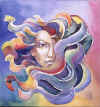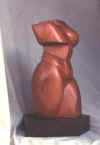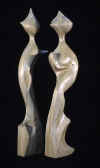Miguel Romero is a Honduran artist studying at The University of
Toledo (Ohio). This page is maintained by Don Stierman, Chair of the Latin American
Studies Institute.
PLEASE NOTE: These are but scans of color slides taken of original
works of art. Colors are but a pale reproduction of the real thing. Poor focus
is also attributable to the reproduction process and not to the originals. These
descriptions were written by the artist. Point and click on the image you wish to
view in greater detail.
- P-17 " Silently": watercolor.12"´ 13" (1994)
 For
years I felt I was torn between the study of two great artistic traditions: the
pre-Colombian Mayan and the classic and classic revival tradition of the western world.
Through my studies I found that both the Greeks and the Mayans had a fancy for line in
common. This is the first piece in which I was able to combine the rational western space
and the thick, dramatic, band-like lines of the Mayans.
For
years I felt I was torn between the study of two great artistic traditions: the
pre-Colombian Mayan and the classic and classic revival tradition of the western world.
Through my studies I found that both the Greeks and the Mayans had a fancy for line in
common. This is the first piece in which I was able to combine the rational western space
and the thick, dramatic, band-like lines of the Mayans.
- P-4 " The Sands of Time": acrylic/canvas (1995)
 This is a
very important work in my career, for it was the first serious experiment I did with
magical realism. It is intended to be a disconcerting painting, one which makes no sense
at all and thus proves to be disturbing and thought provoking to the viewer. It is the
relationship between the objects depicted what is so unusual about it (e.g., the mountains
inside the big sea shell, two faces splitting apart, a coral reef that is smaller than an
egg, etc.). Yet in the midst of all the confusion it arouses, the work does express
something about our human journey through time, nature and society.
This is a
very important work in my career, for it was the first serious experiment I did with
magical realism. It is intended to be a disconcerting painting, one which makes no sense
at all and thus proves to be disturbing and thought provoking to the viewer. It is the
relationship between the objects depicted what is so unusual about it (e.g., the mountains
inside the big sea shell, two faces splitting apart, a coral reef that is smaller than an
egg, etc.). Yet in the midst of all the confusion it arouses, the work does express
something about our human journey through time, nature and society.
- P-30 "Xochitl": watercolor 8 ¼"´ 12 ½" (1995)
 What
started out as a few structural lines in a piece of watercolor paper became one of my
dearest works about the relationship between color and line. Furthermore, it is one of my
most evoking pieces on Latin-American cultural identity. Yes, the tropical America I love
so dearly has deep roots in my work, just as its utopia does in the heart of its people.
What
started out as a few structural lines in a piece of watercolor paper became one of my
dearest works about the relationship between color and line. Furthermore, it is one of my
most evoking pieces on Latin-American cultural identity. Yes, the tropical America I love
so dearly has deep roots in my work, just as its utopia does in the heart of its people.
- P-35 "The Eye of the Iguana": acrylic/canvas
22"´ 28 (1996)
 As a
youth I spent several months living in the Lenca region of western Honduras. The Lencas, a
syncretic ethnic group, became in the years after this experience an ever more important
part of my work. Reality is magical to them, and their form of Catholicism - and religion
is an important asset of that magical reality - is quite different from the Roman
tradition. What I learned with them lit greatly my conception of just how diverse Latin
America is. The Iguana, a quasi-mythical animal in their belief, became, thanks to its
heavily textured skin, the perfect imagery to represent a rampantly striving Latin America
that is formed by as many colors as there are peoples in it. A culturally rich but still
unified Latin America. A Latin America courageously fighting for the utopia at the core of
its existence, a battle that is its own survival.
As a
youth I spent several months living in the Lenca region of western Honduras. The Lencas, a
syncretic ethnic group, became in the years after this experience an ever more important
part of my work. Reality is magical to them, and their form of Catholicism - and religion
is an important asset of that magical reality - is quite different from the Roman
tradition. What I learned with them lit greatly my conception of just how diverse Latin
America is. The Iguana, a quasi-mythical animal in their belief, became, thanks to its
heavily textured skin, the perfect imagery to represent a rampantly striving Latin America
that is formed by as many colors as there are peoples in it. A culturally rich but still
unified Latin America. A Latin America courageously fighting for the utopia at the core of
its existence, a battle that is its own survival.
- 1-S "Red Geometric Nude": mahogany 15 ½"
high (1995)
 Sculpture
was of all the arts, my first love. Now it is just about all I do. This is one of my truly
important carvings. In it I was able to blend the importance of the material and my
plastic concerns for the figure. It is a sculpture about the analysis and abstraction of
form, about the appropriation of a centuries old imagery: the nude. Undoubtedly it is an
expressionist sculpture.
Sculpture
was of all the arts, my first love. Now it is just about all I do. This is one of my truly
important carvings. In it I was able to blend the importance of the material and my
plastic concerns for the figure. It is a sculpture about the analysis and abstraction of
form, about the appropriation of a centuries old imagery: the nude. Undoubtedly it is an
expressionist sculpture.
- S-19 "Lovers": poplar wood 21 ½" high (1997)
 Though
lately I have been doing a lot of bronze casting, I feel my heart warmest at carving.
Sculpture is a hard thing to do because it requires a lot of knowledge, especially when it
comes to keeping a balance between craftsmanship and expressive intentions. Though touch,
sense of full-roundness, serpentine rhythms and wood grain are important in this work, it
is how the pieces complement each other what is unique about this piece.
Though
lately I have been doing a lot of bronze casting, I feel my heart warmest at carving.
Sculpture is a hard thing to do because it requires a lot of knowledge, especially when it
comes to keeping a balance between craftsmanship and expressive intentions. Though touch,
sense of full-roundness, serpentine rhythms and wood grain are important in this work, it
is how the pieces complement each other what is unique about this piece.
How to contact the artist:
Return to Latin American Studies Institute
Last updated 01/12/01

 For
years I felt I was torn between the study of two great artistic traditions: the
pre-Colombian Mayan and the classic and classic revival tradition of the western world.
Through my studies I found that both the Greeks and the Mayans had a fancy for line in
common. This is the first piece in which I was able to combine the rational western space
and the thick, dramatic, band-like lines of the Mayans.
For
years I felt I was torn between the study of two great artistic traditions: the
pre-Colombian Mayan and the classic and classic revival tradition of the western world.
Through my studies I found that both the Greeks and the Mayans had a fancy for line in
common. This is the first piece in which I was able to combine the rational western space
and the thick, dramatic, band-like lines of the Mayans. 
